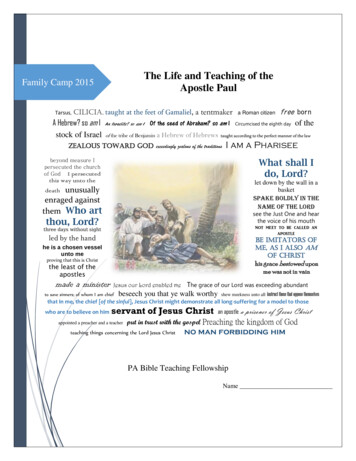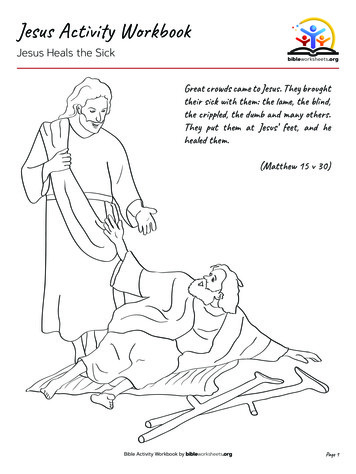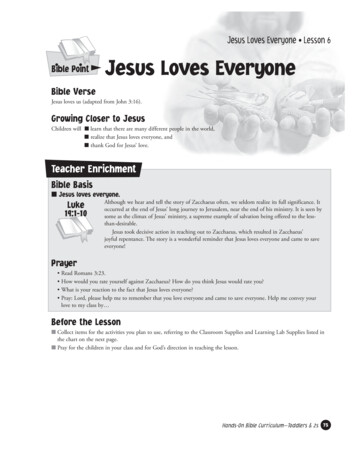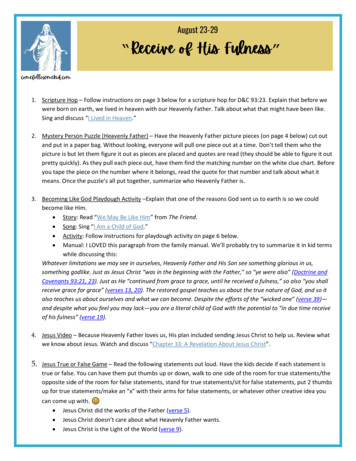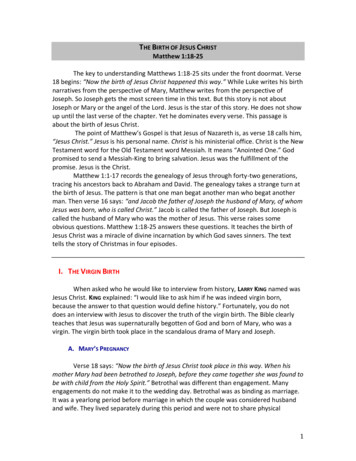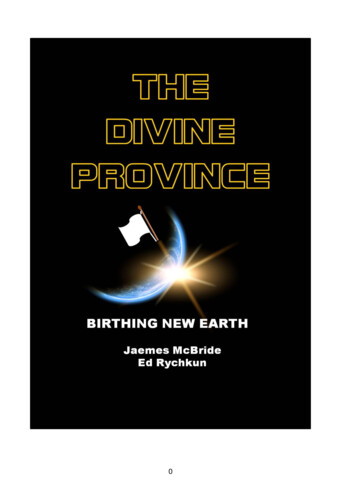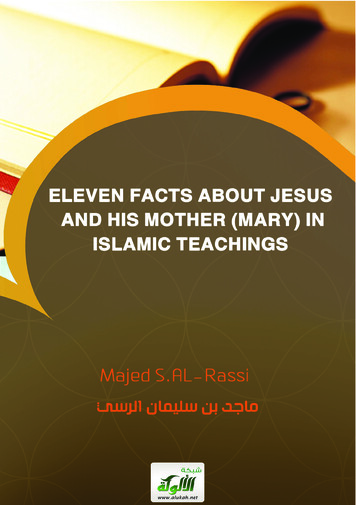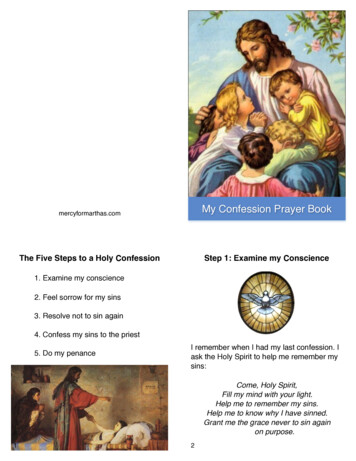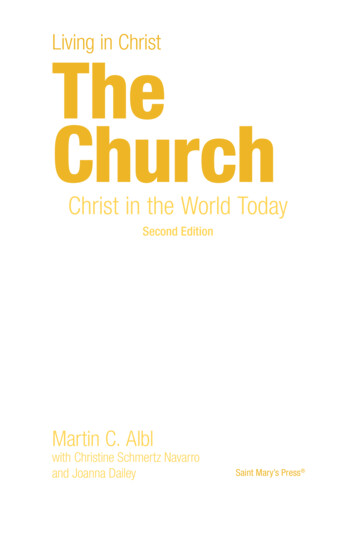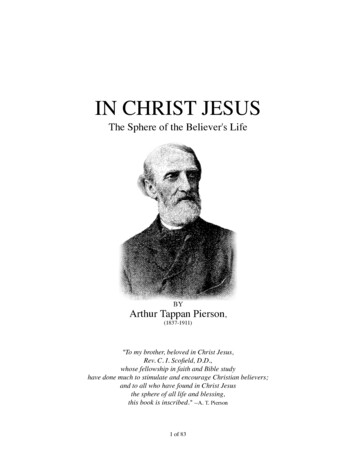
Transcription
IN CHRIST JESUSThe Sphere of the Believer's LifeBYArthur Tappan Pierson,(1837-1911)"To my brother, beloved in Christ Jesus,Rev. C. I. Scofield, D.D.,whose fellowship in faith and Bible studyhave done much to stimulate and encourage Christian believers;and to all who have found in Christ Jesusthe sphere of all life and blessing,this book is inscribed." --A. T. Pierson1 of 83
In Christ Jesus by A. T. PiersonPublished in1898Scripture Annotated VersionThis book is in the public domain.Reformatted by Katie StewartIntroduction to the Book"There is in a Russian palace, a famous 'Saloon of Beauty,' [WStS Note-- Definition: "saloon 2. A large room orhall for receptions, public entertainment, or exhibitions." --from The American Heritage Dictionary.] wherein are hung overeight hundred and fifty portraits of young maidens. These pictures were painted by Count Rotari, forCatharine the Second, the Russian empress; and the artist made a journey, through the fifty provincesof that vast empire of the north, to find his models.In these superb portraits that cover the walls of this saloon, there is said to be a curiously expressedcompliment to the artist's royal patron, a compliment half concealed and half revealed. In eachseparate picture, it is said, might be detected, by the close observer, some hidden, delicate reference tothe empress for whom they were painted. Here a feature of Catharine appears; there an attitude isreproduced, some act, some favorite adornment or environment, some jewel, fashion, flower, style ofdress, or manner of life -- something peculiar to, or characteristic of, the empress -- so that the wallsof the saloon are lined with just so many silent tributes to her beauty, or compliments to her taste. Soinventive and ingenious is the spirit of human flattery when it seeks to glorify a human fellow-mortal,breaking its flask of lavish praise on the feet of an earthly monarch.The Word of God is a picture gallery, and it is adorned with tributes to the blessed Christ of God theSavior of mankind. Here a prophetic portrait of the coming One, and there an historic portrayal ofHim who has come, here a typical sacrifice, and there the bleeding Lamb to whom all sacrifice lookedforward; here a person or an event that foreshadowed the greatest of persons and the events that arethe turning points of history; now a parable, a poem, an object lesson, and then a simple narration orexposition or explanation, that fills with divine meaning the mysteries that have hid their meaning forages, waiting for the key that should unlock them. But, in whatever form or fashion, whatever guise offact or fancy, prophecy or history, parable or miracle, type or antitype, allegory or narrative, adiscerning eye may everywhere find Him -- God's appointed Messiah, God's anointed Christ. Not ahuman grace that has not been a faint forecast or reflection of His beauty, in whom all grace wasenshrined and enthroned -- not a virtue that is not a new exhibition of His attractiveness. All that isglorious is but a phase of His infinite excellence, and so all truth and holiness, found in the HolyScripture, are only a new tribute to Him who is the Truth, the Holy One of God.This language is no exaggeration; on such a theme not only is exaggeration impossible, but the utmost2 of 83
In Christ Jesus by A. T. Piersonsuperlative of human language falls infinitely short of His divine worth, before whose indescribableglory cherubim and seraphim can only bow, veiling their faces and covering their feet. The nearer wecome to the very throne where such majesty sits, the more are we awed into silence. The more weknow of Him, the less we seem to know, for the more boundless and limitless appears what remains tobe known. Nothing is so conspicuous a seal of God upon the written Word, as the fact thateverywhere, from Genesis to Revelation, we may find the Christ; and nothing more sets the seal ofGod upon the living Word than the fact that He alone explains and reveals the Scriptures.Our present undertaking is a very simple one. We seek to show, by a few examples, the boundlessrange and scope of one brief phrase of two or three short words: in Christ, or, in Christ Jesus. A verysmall key may open a very complex lock and a very large door, and that door may itself lead into avast building with priceless stores of wealth and beauty. This brief phrase -- a preposition followed bya proper name -- is the key to the whole New Testament.Those three short words, in Christ Jesus, are, without doubt, the most important ever written, even byan inspired pen, to express the mutual relation of the believer and Christ. They occur, with theirequivalents, over one hundred and thirty times. Sometimes we meet the expression, in Christ or inChrist Jesus, and again in Him, or in whom, etc. And sometimes this sacred name, or its equivalentpronoun, is found associated with other prepositions -- through, with, by; but the thought is essentiallythe same. Such repetition and variety must have some intense meaning. When, in the Word of God, aphrase like this occurs so often, and with such manifold applications, it can not be a matter ofaccident; there is a deep design. God's Spirit is bringing a truth of the highest importance before us,repeating for the sake of emphasis, compelling even the careless reader to give heed as to some vitalteaching.What that teaching is, in this case, it is our present purpose to inquire, and, in the light of the Scriptureitself, to answer.First of all, we should carefully settle what this phrase, in Christ, or in Christ Jesus, means.If there be one truth of the Gospel that is fundamental, and underlies all else, it is this: A new life inChrist Jesus. He, Himself, clearly and forcibly expressed it in John 15:4: "Abide in me and I in you."By a matchless parable our Lord there taught us that all believers are branches of the Living Vine, andthat, apart from Him we are nothing and can do nothing because we have in us no life. This truth findsexpression in many ways in the Holy Scripture, but most frequently in that short and simple phrasewe are now considering -- in Christ Jesus.Such a phrase suggests that He is to the believer the sphere of this new life or being. Let us observe -a sphere rather than a circle. A circle surrounds us, but only on one plane; but a sphere encompasses,envelopes us, surrounding us in every direction and on every plane. If you draw a circle on the floor,and step within its circumference, you are within it only on the level of the floor. But, if that circlecould become a sphere, and you be within it, it would on every side surround you -- above and below,before and behind, on the right hand and on the left. Moreover, the sphere that surrounds you alsoseparates you from whatever is outside of it. Again, in proportion as such a sphere is strong it alsoprotects whatever is within it from all that is without -- from all external foes or perils. And yet again,3 of 83
In Christ Jesus by A. T. Piersonit supplies, to whomsoever is within it, whatever it contains. This may help us to understand the greattruth taught with such clearness, especially in the New Testament. Christ is there presented throughoutas the sphere of the believer's whole life and being, and in this truth are included these conditions:First, Christ Jesus surrounds or embraces the believer, in His own life; second, He separates thebeliever in Himself from all hostile influences; third, He protects him in Himself from all perils andfoes of his life; fourth, He provides and supplies in Himself all that is needful.We shall see a further evidence of the vital importance of the phrase, in Christ, in the fact that thesetwo words unlock and interpret every separate book in the New Testament. Here is God's own key,whereby we may open all the various doors and enter all the glorious rooms in this Palace Beautiful,and explore all the apartments in the house of the heavenly Interpreter, from Matthew to theApocalypse, where the door is opened into heaven. Each of the four gospel narratives, the book of theActs, all of the epistles of Paul and Peter, James and John, and Jude, with the mysterious Revelationof Jesus Christ, show us some new relation sustained by Christ Jesus to the believer, some new aspectof Christ as his sphere of being, some new benefit or blessing enjoyed by him who is thus in ChristJesus.To demonstrate and illustrate this is the aim of this study of the New Testament. And, for brevity'ssake, it may be well to confine our examination to the epistles of Paul, from Romans to Thessalonians,which will be seen to bear to each other, and to the phrase we are studying, a unique and completerelation. We shall trace this phrase in every one of these epistles, and find it sometimes recurring withmarked frequency and variety, generally very close to the very beginning of each epistle; and usuallywe shall find also that the first occurrence of the phrase, in each epistle, determines its particularrelation to that particular book, thus giving us a key to the special phase of the general subjectpresented in that epistle. The more we study the phrase and the various instances and peculiarvarieties of such recurrence, the more shall we be convinced of its vital importance to all practicalholy living.In tracing the uses and bearings of this significant phrase, it will serve the purpose we have in view toregard the epistles to each of the various churches as one, even when there are two. This will give usseven instances of the application of the phrase, which will be found to be similar in the two Epistlesto the Corinthians and the two addressed to the Thessalonians. We may for our purpose, therefore,regard both epistles in each of these cases as parts of one; and we shall, therefore, have before us thissimple study: to examine the particular application of this expression, in Christ, or in Christ Jesus, asused by Paul in writing to the Romans, the Corinthians, the Galatians, the Ephesians, the Philippians,the Colossians, and the Thessalonians." --A. T. Pierson.Table of ContentsIntroduction1. The Epistle to the Romans4 of 83
In Christ Jesus by A. T. Pierson2. The Epistles to the Corinthians3. The Epistle to the Galatians4. The Epistle to the Ephesians5. The Epistle to the Philippians6. The Epistle to the Colossians7. The Epistles to the Thessalonians8. Conclusion.CHAPTER 1The Epistle to the RomansAt the very opening of this letter (1:5), we read these words: "By whom [or, through whom] we havereceived grace" ( i.e., through God's Son, Jesus Christ, our Lord); and, in 3:24, "Being justified freelyby His grace through the redemption that is in Christ Jesus." Here then we have the key to the Epistleto the Romans: Grace, justification, redemption, in and through Christ Jesus; or, to put it briefly,Justified in Christ.This is manifestly the first step, for this conception belongs first in order. We can have, in Christ Jesus,nothing else, unless and until we have first justification -- a new standing before God.Paul is inspired to begin this epistle by showing that all men, Jews and Gentiles alike, are includedunder sin and therefore involved in condemnation. No sinner has before him any prospect but divinewrath, until he is first freed from the law, no longer under condemnation. Hence the first unfolding ofgrace in the epistles is the plain revelation of God's marvelous plan, whereby sinners get the standingof saints. The question, how the condemned may become justified; the lost, saved; the alienated,reconciled; this is the question first and fully answered in this epistle.If we examine chapter 5:1-11,["1 Therefore being justified by faith, we have peace with God through our LORD JesusChrist: 2 by Whom also we have access by faith into this grace wherein we stand, andrejoice in hope of the glory of God. 3 And not only so, but we glory in tribulations also:knowing that tribulation worketh patience; 4 and patience, experience; and experience,hope: 5 and hope maketh not ashamed; because the love of God is shed abroad in ourhearts by the Holy Ghost which is given unto us. 6 For when we were yet withoutstrength, in due time Christ died for the ungodly. 7 For scarcely for a righteous man will5 of 83
In Christ Jesus by A. T. Piersonone die: yet peradventure for a good man some would even dare to die. 8 But Godcommendeth His love toward us, in that, while we were yet sinners, Christ died for us. 9Much more then, being now justified by His Blood, we shall be saved from wrath throughHim. 10 For if, when we were enemies, we were reconciled to God by the Death of HisSon, much more, being reconciled, we shall be saved by His Life. 11 And not only so, butwe also joy in God through our LORD Jesus Christ, by Whom we have now received theAtonement" (Romans 5:1-11).]we shall eight times meet the phrase, through, by, or in Jesus Christ; or its equivalent. And here arerepresented, as bestowed upon us freely, in or through Him, justification, peace with God, access byfaith, a gracious standing, rejoicing in hope of the glory of God; and, even in the experience oftribulation, the love of God shed abroad in the heart, salvation from wrath, reconciliation, safekeepingin His life, perpetual joy in God, etc.**Dr. Handley C. G. Moule, of Cambridge, England, in his matchless commentary on Romans,thus translates verses 10 and 11: "Much more being reconciled we shall be kept safe in Hislife; and, not only so, but we shall be kept always rejoicing in God."Blessed indeed to meet, as we begin our study of the epistles of the New Testament, this firstapplication of the phrase, in Jesus Christ: Christ is the sphere of our justification, with all that thisinvolves: reconciliation, redemption, eternal life, safekeeping. In Him the sinner at once becomes, inGod's sight, a saint, admitted to a new standing, not on the platform of law, but of grace. Outside ofChrist, is alienation; inside this sphere, reconciliation; without, death; within, life; without, enmity;within, peace. By faith we are taken into Christ, made at once safe from holy wrath against sin, andkept safe from all perils and penalties. He, our divine Redeemer, becomes to us the new sphere ofharmony and unity with God and His law, with His life and His holiness.As already intimated, each epistle has its own definite limits of application for the phrase, in ChristJesus, and the divine truth which it conveys; and in each the range of thought is limited, in the main,by certain typical and representative events in the history and career of the God-man. In this epistle, itis to the death, burial, and resurrection of our Lord Jesus Christ that the thoughts of the reader arepreeminently directed, because these events belong together as forming the very foundation of ourjustification. Compare chapter 4:25: "Who was delivered for our offences and raised again for ourjustification." Here it is made unmistakably plain that the death and resurrection of Christ, togetherwith the burial which lay between, accomplished the work of our justification. Death was thedelivering over of our vicarious Substitute and Surety to the penalty of a broken law; burial was Hiscommittal to the grave, as dead; and resurrection was the deliverance from both death and hades, asthe divine sign and seal of His acceptance as our Substitute and Surety and of His vicarious atonementin our behalf.We have heard of a Russian officer whose accounts could not be made to balance, and who feared thatthe merciless despotism of the empire would allow no room for leniency in dealing with him. Whilehopelessly poring over his balance sheet and in despair of ever making up his deficiency, it is said thathe wrote, half inadvertently, on the paper before him: "Who can make good this deficit?" and fellasleep at his table. The czar passed, saw the sleeping officer, glanced curiously at the paper, andtaking up the pen, wrote underneath: "I, even I, Alexander." The story may be a fiction, but itillustrates a far higher debt that is forever canceled. Does the hopeless sinner confront his awful6 of 83
In Christ Jesus by A. T. Piersonbankruptcy and ask in despair, "What can pay this my debt to a broken law?" There is One who diedand rose again, who from the cross of Calvary, the tomb in the garden, and the throne in heaven,answers, "I, even I, the Lord Jesus."Let us then fix in our minds that the special horizon of this epistle is bounded by Christ's justifyingwork, and includes within its scope these three prominent facts: He died, He was buried, He roseagain. All the great lessons here taught center about the cross and the sepulcher. Christ was the secondand last Adam; the representative of the race; and so, judicially, He stands for the believer. In Hisdeath, the believing sinner is reckoned as having died for sin, and unto sin; in His burial, as havinggone down into the grave, the place of death, decay, and corruption, there to leave as crucified, deadand buried, "the old man," the old nature, and the old life of sin, now forever "put off" in Christ, "thetime past of our life sufficing to have wrought our own will;" and, in Christ's resurrection, the believeris counted by God as having come forth, having "put on the new man, which after God is created inrighteousness and true holiness" (Ephesians 4:24), endowed with a new Spirit of Life, henceforth to"walk in newness of life" (Romans 4:4).The believer's vital union with Christ Jesus is set forth, with great clearness of statement, in chapter6:4-11,["4 Therefore we are buried with Him by baptism into death: that like as Christ was raisedup from the dead by the Glory of the Father, even so we also should walk in newness oflife. 5 For if we have been planted together in the likeness of His Death, we shall be alsoin the likeness of His Resurrection: 6 knowing this, that our old man is crucified withHim, that the body of sin might be destroyed, that henceforth we should not serve sin. 7For he that is dead is freed from sin. 8 Now if we be dead with Christ, we believe that weshall also live with Him: 9 knowing that Christ being raised from the dead dieth no more;death hath no more dominion over Him. 10 For in that He died, He died unto sin once: butin that He liveth, He liveth unto God. 11 Likewise reckon ye also yourselves to be deadindeed unto sin, but alive unto God through Jesus Christ our LORD" (Romans 6:4-11).]where his identification with the Lord Jesus in His death, burial, and resurrection is so plainlydeclared, and its practical bearings are shown. Compare II Corinthians 13:4: "For though he wascrucified through weakness, yet he liveth by the power of God. For we also are weak in him, but weshall live with him by the power of God toward you."In this sixth chapter of Romans seven significant statements are noticeable, and upon them the wholeargument hangs and turns:1.Christ was raised from the dead by the glory of the Father; that is, He was divinelyquickened or made alive, so that His resurrection was a miracle.["As Christ was raised up from the dead by the Glory of the Father, even sowe also should walk in newness of life" (Romans 6:4).]2.We, as believers, are planted together with Him in the likeness of His resurrection; thatis, we share in the very power of God which raised Him from the dead.7 of 83
In Christ Jesus by A. T. Pierson["For if we have been planted together in the likeness of His Death, we shallbe also in the likeness of His Resurrection" (Romans 6:5).]3.Our old man is crucified with Him; that is, the former sinful nature is judiciallyregarded as crucified, dead, buried, and left in the tomb of Christ.["Knowing this, that our old man is crucified with Him" (Romans 6:6).]4.That the body of sin might be destroyed, that henceforth we should not serve sin; thatis, the power of sin as our master is practically broken, and we are released.["That the body of sin might be destroyed, that henceforth we should notserve sin" (Romans 6:6).]5.We believe that we shall also live with Him. Surely, we are not to refer this only to ourfinal resurrection; from His resurrection, onward, forevermore, our life is one with His.["Now if we be dead with Christ, we believe that we shall also live withHim" (Romans 6:8).]6.Death hath no more dominion over Him, and so we in Him are delivered from all thatdominion of sin which is implied in death as its judicial penalty. Compare verse 14.["9 Knowing that Christ being raised from the dead dieth no more; death hathno more dominion over Him. 14 For sin shall not have dominion over you:for ye are not under the Law, but under Grace" (Romans 6:9, 14).]7.In that He liveth, He liveth unto God, and to us also God is to be the source, channel,and goal of our new life, and so we are to manifest our unity with Him.["For in that He died, He died unto sin once: but in that He liveth, He livethunto God" (Romans 6:10).]This teaching is so wonderful that it would be incredible were it not found in the inspired Scripture,and thus sealed with the authority of the divine Teacher. It is manifestly a revelation from God, for itnever would have entered into the heart of any mere man, untaught of God, to conceive it.This reminds one of a most forcible utterance of Sir Monier Williams, professor of Sanskrit in OxfordUniversity, and, perhaps, the greatest living authority on all questions affecting the literature andfaiths of the Orient. At an anniversary of the Church Missionary Society in London, some ten yearsago,* he delivered a most remarkable address, in which he said that, when he began investigatingHinduism and Buddhism, he began to believe in what is called the evolution and growth of religiousthought. But he adds, and we give his own memorable words:*Editor's note: This book was first published in 1898."I am glad of the opportunity of stating publicly, that I am persuaded I was misled by theattractiveness of such a theory, and that its main idea was erroneous. And now I crave8 of 83
In Christ Jesus by A. T. Piersonpermission at least to give two good reasons for venturing to contravene the favoritephilosophy of the day. Listen to me, ye youthful students of the so-called sacred books ofthe East: search them through and through, and tell me, do they affirm of Vyasa, ofZoroaster, of Confucius, of Buddha, of Mohammed, what our Bible affirms of thefounder of Christianity, -- that He, a sinless man, was made sin? Not merely that He is theeradication of sin, but that He, the sinless son of man, was himself made sin. Vyasa andthe other founders of Hinduism, enjoined severe penances, endless lustral washings,incessant purifications, infinite repetitions of prayer, painful pilgrimages, arduous ritual,and sacrificial observances, all with the one idea of getting rid of sin. All their books sayso. But do they say that the very men who exhausted every invention for the eradicationof sin were themselves sinless men made sin?. This proposition put forth in our Biblestands alone, it is wholly unparalleled; it is not to be matched by the shade of a shadow ofa similar declaration in any other book claiming to be the exponent of the doctrine of anyother religion in the world.Once again, do these sacred books of the East affirm of Vyasa, of Zoroaster, ofConfucius, of Buddha, of Mohammed, what our Bible affirms of the founder ofChristianity, that He, a dead and buried man, was made life. Not merely that He is thegiver of life, but that He, the dead and buried man, is life. All I contend for is, that sucha statement is absolutely unique; and I defy you to produce the shade of a shadow of asimilar declaration in any other sacred book of the world. And bear in mind that thesetwo matchless unparalleled declarations are closely, intimately, in dissolubly connectedwith the great central facts and doctrines of our religion: the incarnation, the crucifixion,the resurrection, the ascension of Christ.The two unparalleled declarations quoted by me from our Holy Bible make a gulfbetween it and the so-called sacred books of the East, which severs the one from theothers utterly, hopelessly, and forever; not a mere rift which may be easily closed up, buta veritable gulf which cannot be bridged over by any science of religious thought, yes, abridgeless chasm which no theory of evolution can ever span."Professor Max Muller, in addressing the British and Foreign Bible Society, declared, in a similarstrain, that "the one key-note of all these so-called sacred books is salvation by works. Our own HolyBible is from the beginning to the end a protest against this doctrine."What Sir Monier Williams and Professor Muller thus affirm of the Word of God, as to its unique andwholly unparalleled teaching, we may find illustrated especially in this epistle. Here, if anywhere, wehave the sinless One made sin for sinners, and the dead One raised from the dead to become life tobelievers; and here, if anywhere, we have salvation by works.We cannot leave this thought without at least hinting at its apologetic and evidential value. Thequestion cannot but arise: Where did the writers of this Bible get conceptions so original and unique?The world of mankind was forty centuries old when the New Testament began to be constructed,when the earliest books first appeared in the primitive Church. At least five great world kingdoms hadin their way carried civilization to remarkable heights of development: the Egyptian, AssyrianBabylonian, Persian, Greek, and Roman. Progress had not been along the lines of commerce, martial9 of 83
In Christ Jesus by A. T. Piersonprowess, material grandeur, and imperial splendor, alone, but philosophy had won some of itsproudest triumphs. The race had done much of its subtlest and most original thinking before theNazarene began his career of teaching. Now, how can it be accounted for that a few humble fishermenof Judea, or even a trained Hebrew scholar who had the advantage of Roman citizenship and Greekculture, should have given to mankind absolutely new ideas, and those, too, on the most vital themes?How came it that such new and marvelous conceptions are found in the Word of God, and nowhereelse?There is but one explanation: The world was visited by the Son of God. He told of heavenly things.He revealed the mind of God on subjects hitherto unveiled. What He had heard in a celestial school -the University of God -- what no scholar or philosopher of earth had even imagined -- He testified,and some received His testimony and set to their seal, experimentally, that God is true. And so itcomes to pass that the Bible -- because it is what it claims to be, God's Word, conveying God'sthought -- gives us absolutely new ideas of the way of salvation, of the sinless sin bearer, of the risenLord of life; and announces the simple terms whereby He becomes to the believer, the sphere of a newlife -- his Justifier, Reconciler, Saviour.Let us tarry at the threshold of our study of this theme, to praise Him who in the Gospel of Christ hasbrought to light, life and immortality; who has made the cross of Calvary a tree of life, and thesepulcher in the garden a doorway of life, and the faith of a little child the condition of life, to everypenitent and believing sinner. Toplady says; "When Christ entered into Jerusalem the people spreadgarments in the way: when He enters into our hearts, we pull off our own righteousness, and not onlylay it under Christ's feet but even trample upon it ourselves."Let a quotation from another writer, referring to Isaiah 53:5, enforce this same lesson:"Let every poor sinner, and let every preacher to sinners put the great truth where Godputs it, in the very center and midst, as the most vital and important of all truths. Howsimple this verse which expresses it! It states facts, facts to which the prophet lookedwonderingly forward, facts on which we look gratefully backward. He, the mighty andthe holy One, He was wounded, bruised, chastised! He was treated thus, not because Hedeserved it, but for our sakes, because we deserved it. His punishment is our peace. Hisstripes are our healing. His death our life. O greatest of all facts! Well mayest Thou havethe central place in prophecy, the central place in our hearts! This is the Gospel. Tobelieve this is to be saved; He has borne the stripes and punishment due to each believer,who will, therefore, have none to bear. To believe this is to be happy, for it is to see asubstitute in our place of doom and death, setting us free! To believe this is to be holy, forfaith in such facts must make us love the One that suffered in our stead, and hate the sinthat brought sore stripes on Him. Brother, canst thou make it singular, and say, 'He waswounded for my transgressions; He was bruised for my iniquities, the chastisement of mypeace was upon Him, and with His stripes I am healed?'"The 20th of January 1896, marked the centenary of John Howard, the philanthropist, who went on hisfamous "circumnavigation of charity" to let light into the dungeons of the world's prisons. His was alife of singular self-sacrifice for others. Beginning amid the cottages of Cardington, and undertakingreforms among his own tenantry, his work grew wider until from the jails and prisons of Britain it10 of 83
In Christ Jesus by A. T. Piersonembraced the cells of the imprisoned everywhere. In Bedford jail, where Bunyan had spent twelveyears a century before, Howard found men and women, who were felons, living in a common dayroom, their night-rooms being two dungeons "down steps." There was only a single courtyard fordebtors and criminals, there was no apartment for the jailer, and the sanitary conditions bred fatal jailfever, which proved destructive also outside prison walls. Howard's whole soul was so moved that he"emptied himself" of all that mortals prize, to go on his wide mission of love, and become a servant ofservants to the lowest and vilest classes.The inscription on his monument is eloquently suggestive:Vixit p
IN CHRIST JESUS The Sphere of the Believer's Life BY Arthur Tappan Pierson, (1837-1911) "To my brother, beloved in Christ Jesus, Rev. C. I. Scofield, D.D., whose fellowship in faith and Bible study have done much to stimulate and encourage Christian believers; and to all who have found in Christ Jesus the sphere of all life and blessing,
